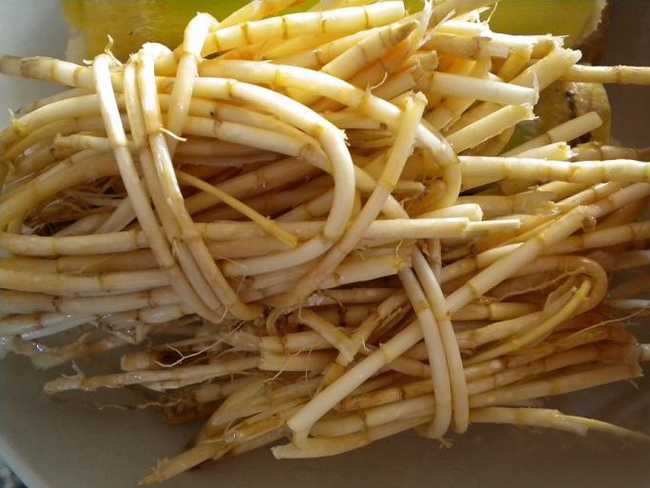Commonly known as Imperata Cylindrica, it refers to the root of a species in the genus Imperata. And some other names for this herb include cogon grass, wolly grass, blady grass, Bai Mao, and kunai grass, etc. It is a perennial grass, which is native to northern Africa, Turkey, Iraq, Central Asia, Caucasus, and Mediterranean. The type specimen comes from southern France. In China, it grows in northern parts like Henan, Liaoning, Shanxi, Shandong, and Xinjiang provinces. And it is found mostly in meadows out on the road, hillsides, seaside, and sandiness grassland, etc.
Japanese blood grass has densely scaly rhizome, erect fascicular stalk, 30 to 90cm in height, and 4 to 10mm pubescence at the nodes. The rhizome is in long cylindrical shape, branching sometimes, 30 to 60cm long at different lengths, and 2 to 4mm in diameter. The surface is yellowish-white or faint yellow in color, lustrous, with vertical wrinkles, obvious nodes with remnant gray-brown scale leaves and radicula, and 1 to 3cm between nodes. It is light and tough in texture. The fibroid transverse section is yellowish-white in color, mostly with radial crevices, sometimes a pinhole seen at the center. It is slightly odorous and slightly sweet in taste.
From the medicinal herb point of view, those preferred are larger in shape, white in color, and sweeter in taste. The medicinal imperata cylindrica is collected during spring and autumn, overground part and scaly sheath removed, washed clean, used in fresh form or dried in the sun in bundles.
WHAT'S IT USED FOR IN TCM?
From the perspective of Traditional Chinese Medicine (TCM), it is cold and sweet in nature and goes to a few of meridians such as lung, stomach, small intestine, and urinary bladder.

Japanese blood grass
Main functions are to cool blood, stop bleeding, promote the secretion of saliva or body fluid, clear heat, promote urination and treat Stranguria. Main uses and indications are fidget and thirst in febrile diseases, vomiting blood due to excessive heat, coughing up blood, nosebleed, short of breath caused by lung heat, hiccup due to stomach heat, uterine bleeding, purpura, stranguria, Edema, and Jaundice, etc. Usual dosage is from 9 to 24 grams.
HERBAL FORMULAS RELATED WITH JAPANESE BLOOD GRASS
(1). Shi Hui San, from Shi Yao Shen Shu (A Miraculous Book on Ten Recipes), is mainly for bleeding at upper part of human body, which is caused by the rampageous blood derailed out of the track of meridians caused by uprush of blazing heat and Qi. Other individual herbs in this formula include Da Ji (Japanese Thistle, Cirsium), Xiao Ji (Small Thistle), He Ye (Lotus Leaf), Ce Bai Ye (Biota Leaves), Qian Cao Gen (Rubia Root), Zhi Zi (Cape Jasmine Fruit, Gardenia), Da Huang (Rhubarb Root), Mu Dan Pi (Tree Peony Root Cortex), and Zong Lu Pi (Trachycarpus Stipule Fiber).
(2). Mao Gen Yin Zi, from Wai Tai Mi Yao (Arcane Essentials from the Imperial Library), is formulated for hematuria due to heat in womb. Other herbs in this formula are Fu Ling (Poria, China Root), Ren Shen (Ginseng Root), and Shu Di Huang (Rehmannia, Chinese Foxglove Root).
(3). Mao Lu Gen Jian, from Yao Wu Yu Fang Ji (Herbs and Formulas), is used for vomit caused by febrile diseases, gastrointestinal bleeding, Hematuria, and uropenia in edema. The other herb is Xian Lu Gen (Fresh Reed Rhizome).

![Diseases, Symptoms, tcm, [tcmwindow.com]](/uploadFile/adImg/2015/11/11/f5cbfcc0-4df5-4646-9b9a-f316651a0199.jpg)





